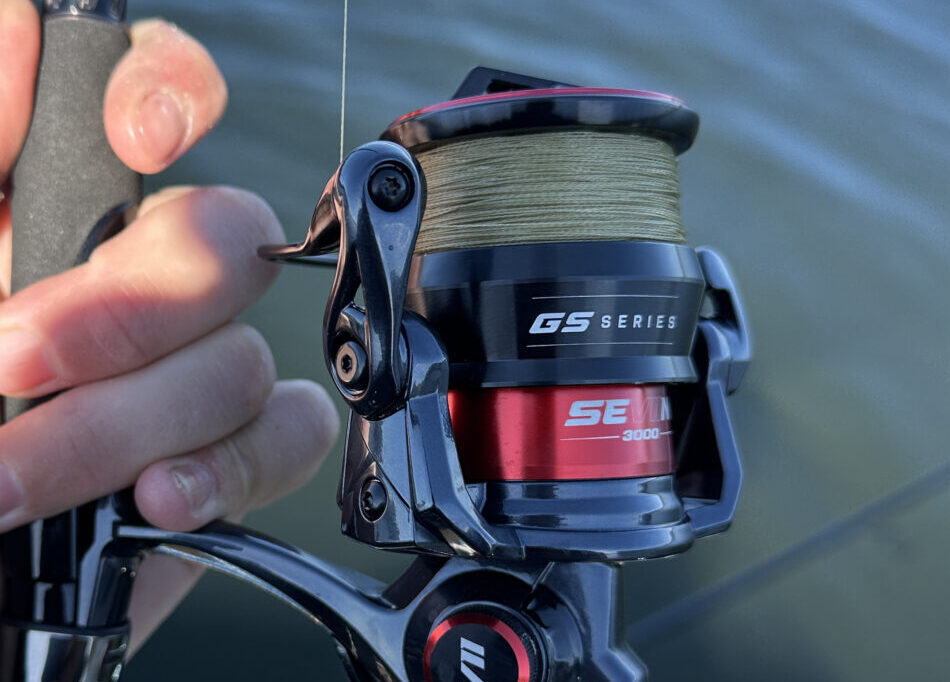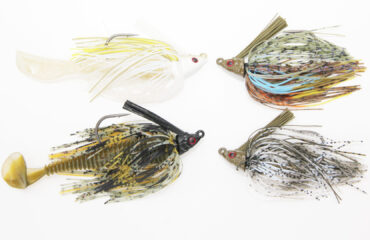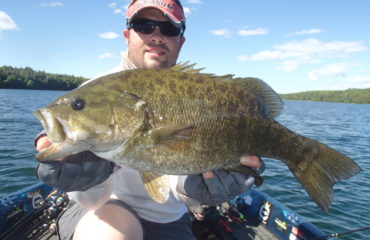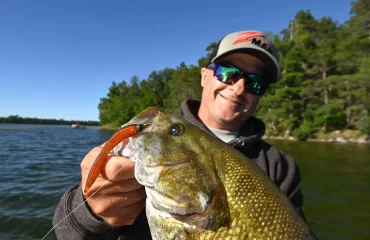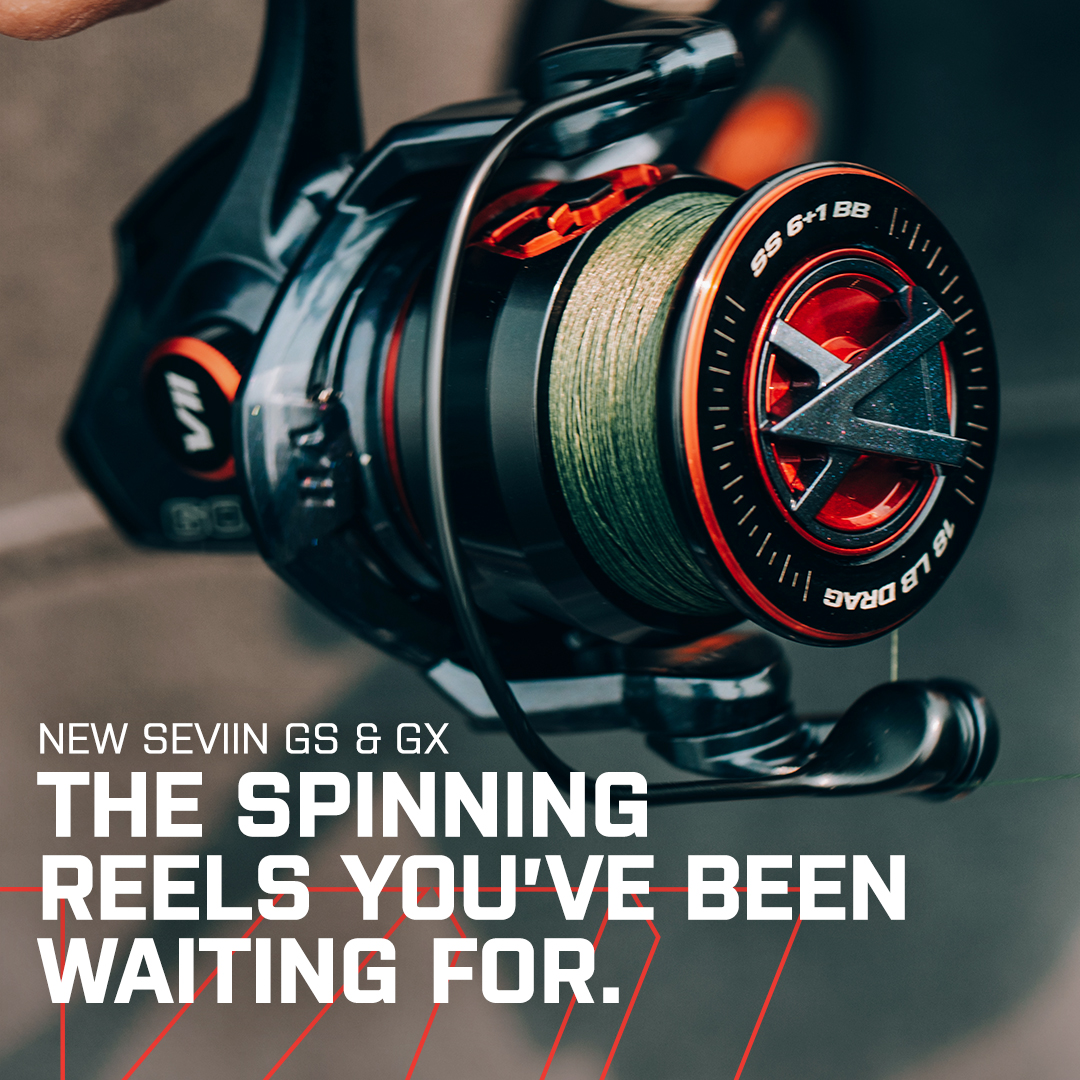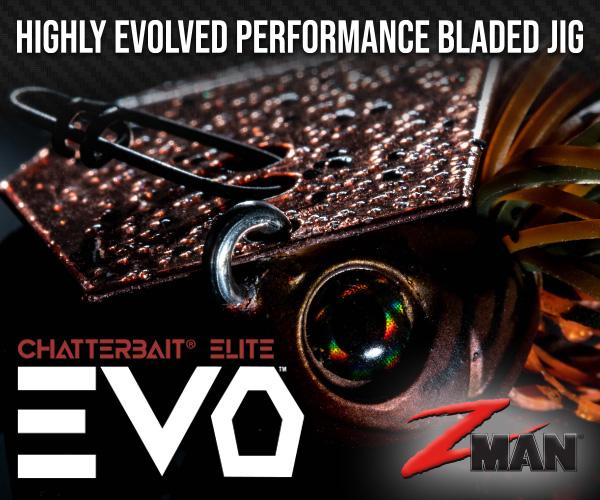Fishing Line Maintenance
Between the demands of guiding and my own personal fishing time, a lot of wear and tear gets put on my vehicle, boats, and equipment throughout the year. Upkeep and maintenance of each is necessary in order for us to perform at a high level, and helps me avoid many problems that could happen in the future.
Whether you realize it or not, fishing line is the most critical link between the fish and you. The other items that get relied on are merely vehicles and tools to help you reach fish. The slightest fishing line imperfection, as a result of improper care, can mean catching fish or failure. Line failure is the most nightmarish of them all, and we’ve all experienced it in one way or another.
Many factors and possible events can lead to line failure. Laziness, neglect, and not being detail-oriented each contribute. Lack of maintenance is the biggest culprit of them all. Whether fishing braids, fluorocarbons, copolymers or monofilaments, each line type requires proper maintenance that includes spooling, tuning, and storage in order to continue performing. These practices will also help prolong the shelf life of your favorite lines, and their continued performance.
When to Replace?
First, it’s imperative to observe, notice, realize, and react when it’s time to replace line and re-spool your reels.
Line replacement should have a balance. If you refuse or delay it, break-offs will become more frequent than catching. I’ve seen this happen frequently to frayed fluorocarbon and rotten monofilament – and I’ve also been a victim too. On the other hand, if you are spool-happy, you’ll potentially cost yourself hundreds of dollars in spools of line that would be an unnecessary expense. 150 and 300-yard spools of braid are expensive enough, but you’ll be surprised by what you can do with worn braid during the re-spool process in order to get an additional extra year or two out of what’s currently on the reel.
Each line type has a warning sign.
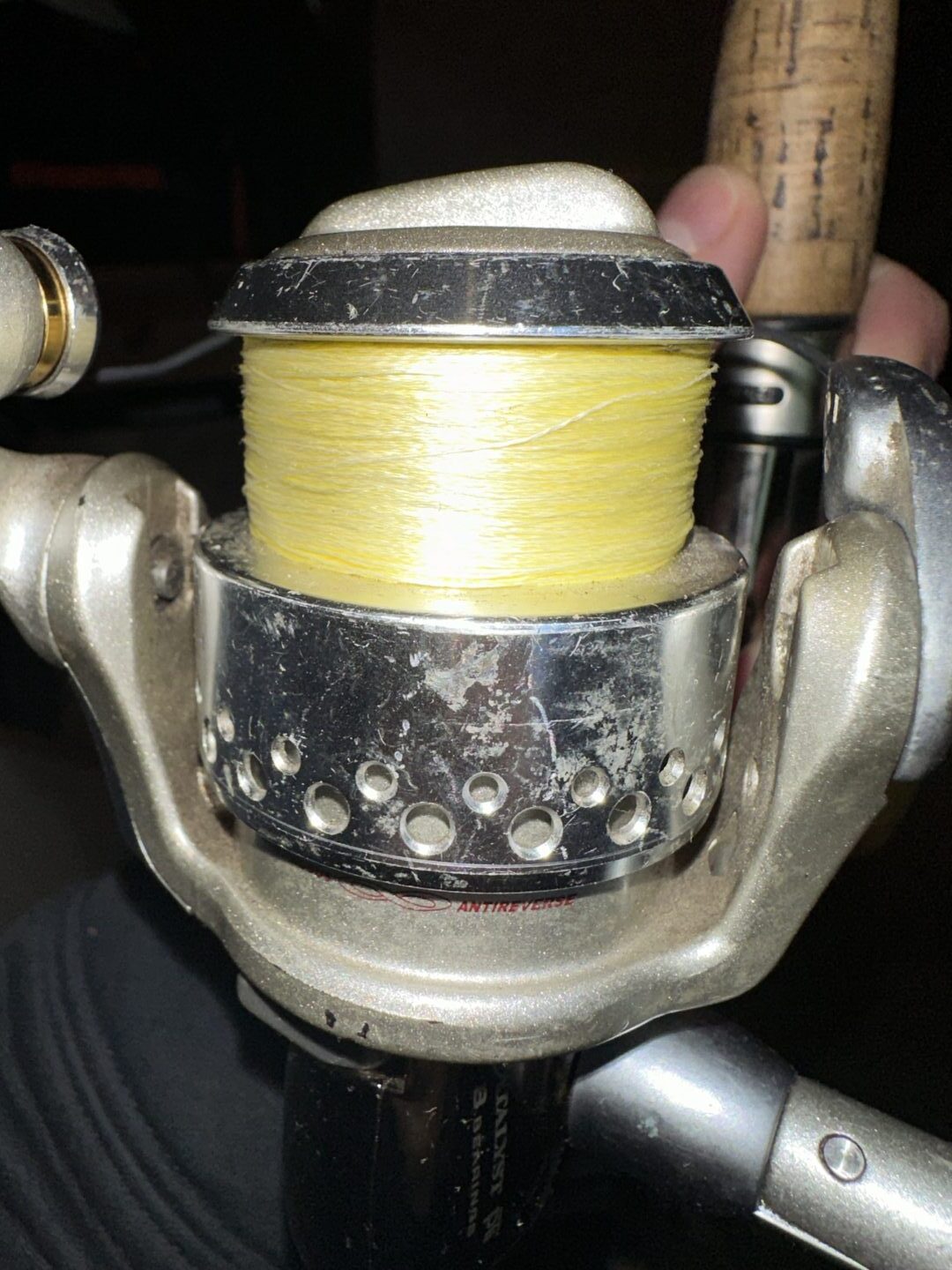
See the discoloration and softness with the first 20-or-so yards of line on the spool? And notice I’m down to 50% capacity? It’s time to re-spool.
Monofilament and Copolymers, the cheapest of them all, has a short shelf life compared to fluorocarbon and braid. New out of the package, it is soft, plasticky in smell and touch, and stretchy. When it either dries, hardens, and loses its stretchability, it is time to replace and discard.
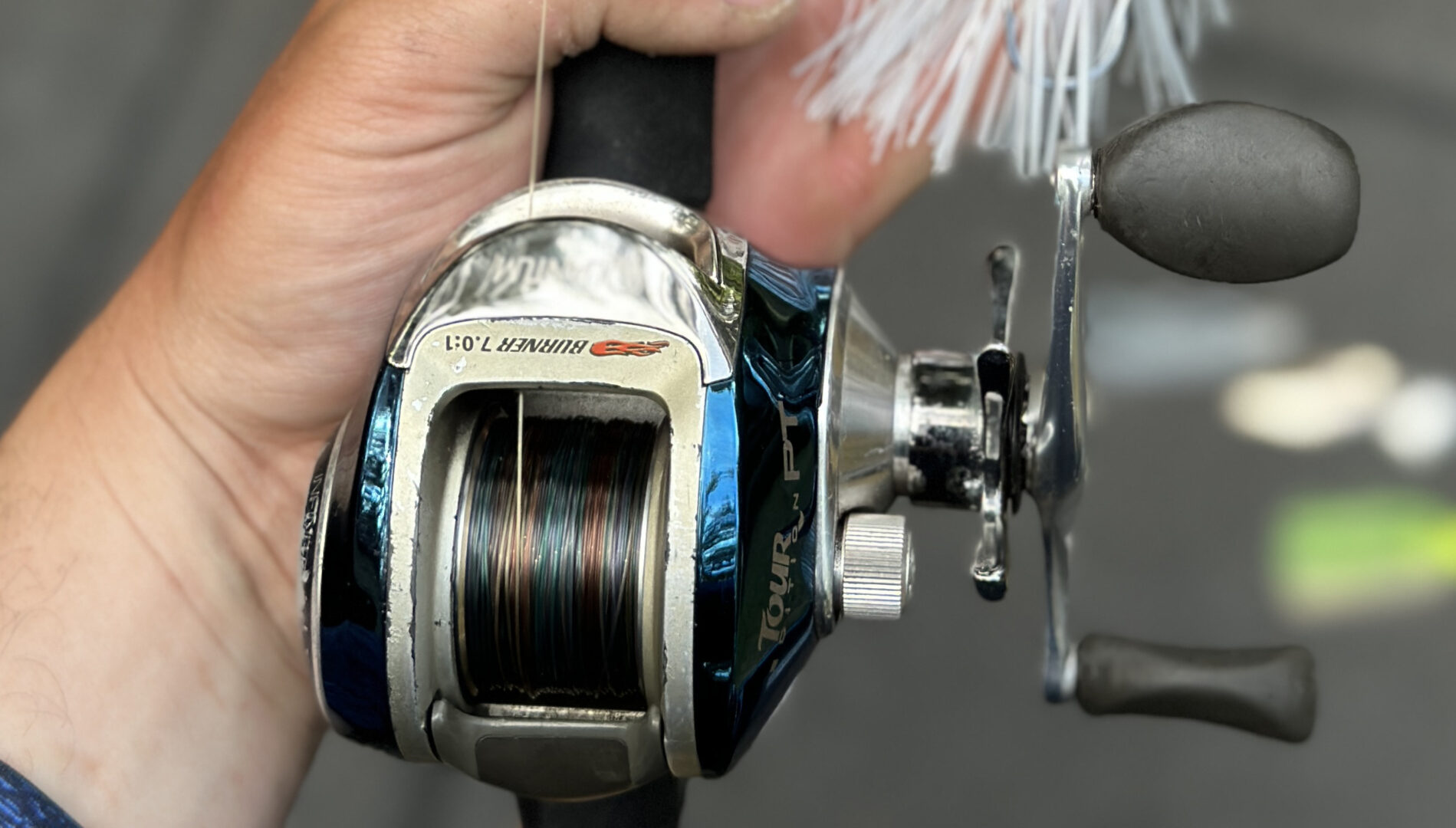
Mono is known to twist, and often times this is the reality of casting with it. Twisting will lead to coiling, wind knots, and abrasions forming more frequently. It is difficult to pick through knots and in most cases you’re better off cutting the line. Consequently, reels spooled with mono will typically go through more line.
Due to lower costs, monofilament gets replaced most frequently. On spinning reels, I replace my spools of Cortland Camouflage every 2 to 3 seasons. On baitcasters, every season – and in some extreme line-loss cases, on a monthly basis.
Fluorocarbon, a sun-sensitive line, requires the most maintenance and upkeep in my opinion. Stiffer in construction and brittle, frays and abrasions are extremely common. Even though most premium lines such as the spools of Sunline and Seaguar I use are advertised for their abrasion-resistance, the construction is not fool-proof. Anytime an imperfection is noticed, cut the damaged section and re-tie.
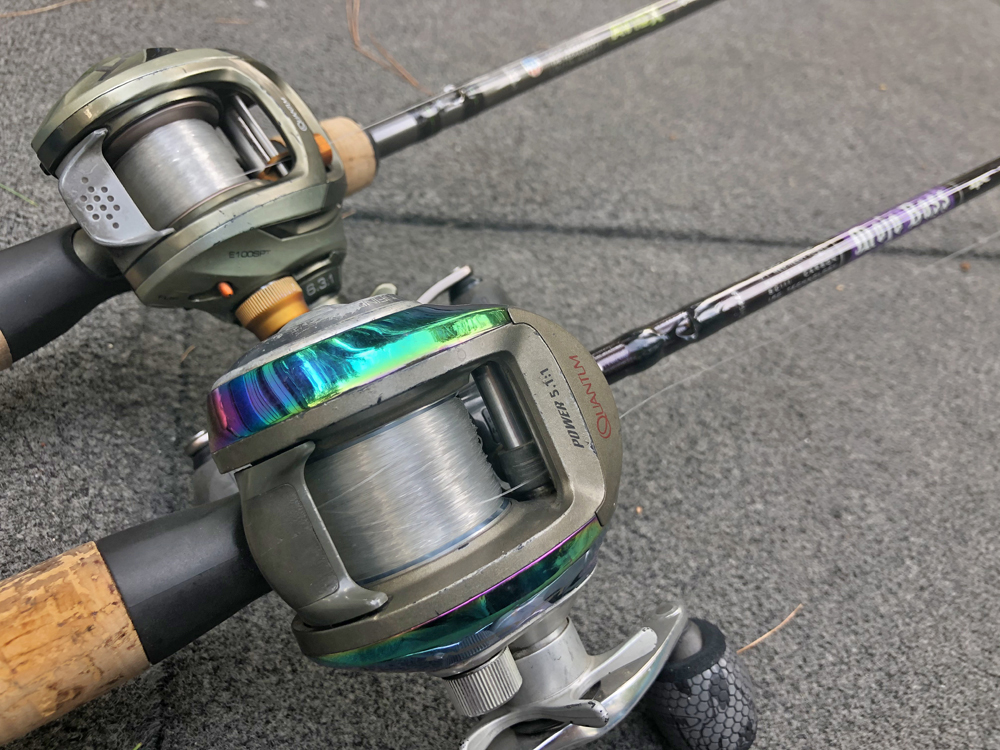
Due to very poor line control and memory issues, fluoro line is mostly unfishable on spinning setups, but adequate enough and most common on baitcasters. Backlashes with it are brutal. As a result, picking through knots can be impossible in most extreme cases. These lines can make you re-spool frequently.
Fluorocarbon weakens the quickest. Knots are also more difficult to tie – any rust or wear in a hook’s eyelet will prevent a strong knot. Look for frays and discolorations in the line. A single knot in the line will cause it to snap under a few pounds of pressure. Any missed detail can result in break-offs on the hook-set. Dispose your line properly when junked – or burn it and use as a fire-starter as I do – as fluorocarbon is (mostly) unable to break-down and decompose.
Re-spooling is costly. My reels with fluoro get re-spooled annually. Since most lines are sold in 150-yard spools, it is expensive for what you get, and has a highest cost per single yard.
For other than leader material, and using as a main line for the casting and deep-water delivery of crankbaits, chatterbaits, and a handful of other search lures, I personally dislike the fishability and functions of fluorocarbon. It clearly requires the most maintenance and troubleshooting.
Braid, is the most easy-going and maintenance-free fishing line of them all. However, it is the most expensive per spool size. Depending on the brand, frequency of use, and the line user’s care, it can outlast all the other line types out there.
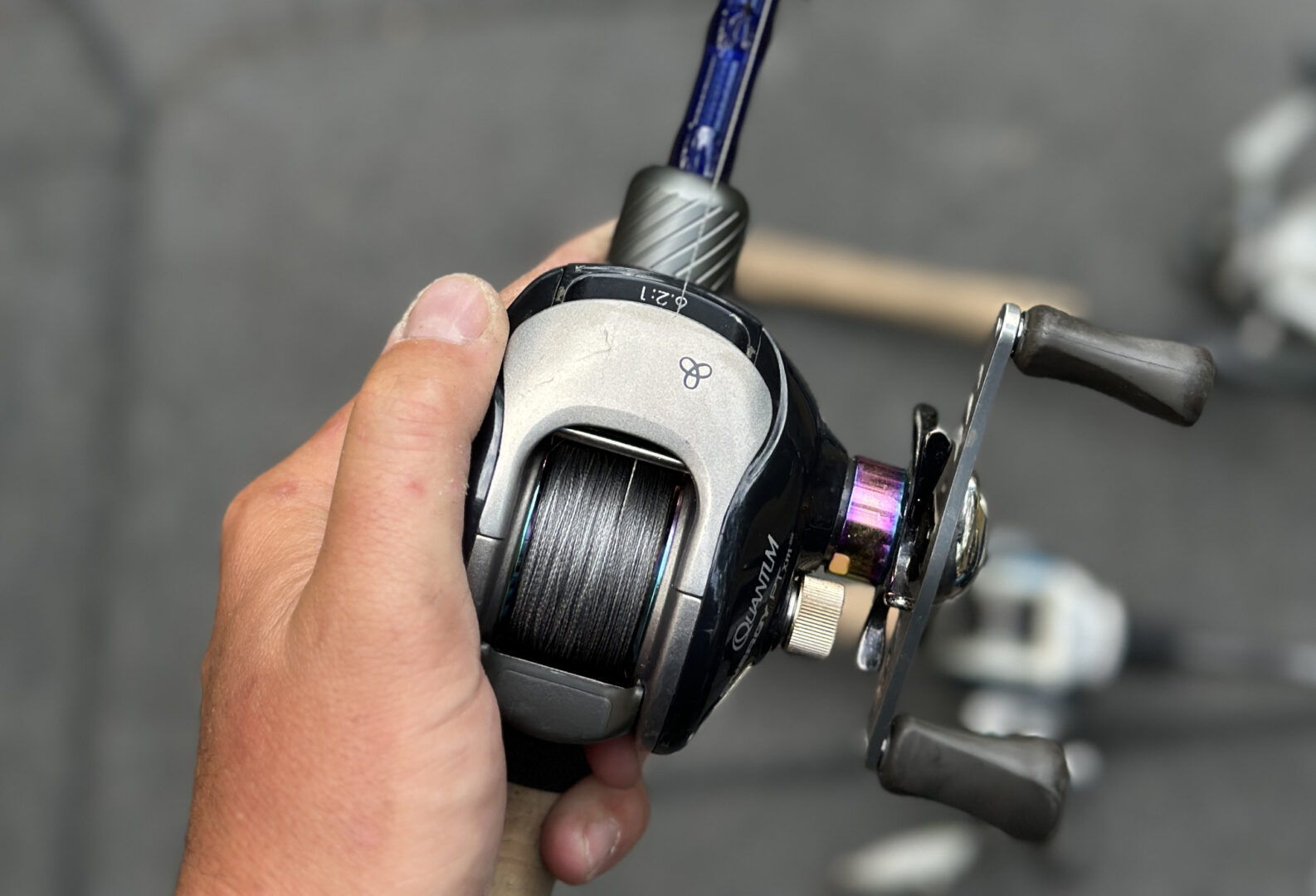
Braided line is known to mislead anglers. Dye fading occurs quickly, depending on usage and casting frequency. Anglers worry when this happens, thinking their reels need to be re-spooled. This is just a product of process, as the integrity and construction of braided line lasts far longer than its coloration.
A good indicator that it’s time to replace your line is when it gets fuzzy and fluffy. This will often occur within the first 5 to 10 feet between lure and spool – the section that passes through rod guides most frequently. On other reels used for casting, this will be evident for the first 30-yards of spool. Observe, and snip line where fuzz meets the next lesser-used segment. Line rot will be most common on lighter lines, between 2-pound to 15-pound sizes.
While durable and strong for casting, braid does not hold up to abrasive conditions. One single cut in a strand of braid will affect and weaken the entire weave. Hence, we frequently snip off damaged and worn sections. Backlashes and wind knots are easiest to pick apart on braid. Usually, all it takes is a line pick, or a sharp hook point (what I do), to pull out loops and undo knots. Having a skill in undoing knots and being careful will save you hundreds of dollars and from having to re-spool.
I fish braids most frequently, but I care and nurture them lots. On average, most of my spinning and casting reels have Cortland Masterbraid that’s been spooled to them for 3 to 5 years already. On my musky reels, I go through braid more frequently, every 2 years on average, as heavy lures and rapid line passage through the rod’s guides will wear on them quicker. I only re-spool when the warning signs are evident, or I’ve lost several yards due to the uncontrollable nature of wind knots and when unable to pick them out.
Spooling
Never grow attached to the first 50-yards of line. The reality of line is this top segment of the spool can be the first to go, anytime. This is replaceable. Depending on reel size and its line capacity, most of my reels have 150 to 200 yards of line on them. It’s important to discard sections of the top segment with frequency, when the issues first begin. Line is only as strong as its weakest link.
Far too many anglers struggle with the line re-spooling process. Whether laziness, motivation, or lack of skill are preventers, most folks are taking their reels to shops where they are getting re-spooled by automated machine. That’s great, but if the spool of fresh line getting winded on has imperfections, the machine won’t stop and do a line recall for you. Most fresh line you’ll get comes off of mass-produced bulk spools. Additionally, relying on shops is time consuming, unreliable, and occasionally costly.

My entire life, I have spooled my own reels manually. I learned this skill at a very young age, and the only requirement needed for it is good hand-eye coordination. My process as it goes:
- Pull all old line off by hand, or by machine (drill is perfect). Ball up old line to dispose safely, or to burn.
- Save the reel’s remaining 50 to 75-yard section of line for your new backing. The reality of line is you’re never really going to use this segment to begin with. You’re always going to go through the top 100-yards till it’s time to re-spool, anyways.
- Fuse backing line and fresh line together with reliable knot such as double-uni or RP knot.
- With rod and reel setup in both hands, and spool of line to the floor (positioned vertically to rotate) supported by a pen or pencil pegged between your two feet an inch off the floor, proceed to spool. Never change position of spool, to maintain smoothness on reel.
- Pressure is needed to apply to line before it reaches spool of reel. With index finger and thumb on rod hand, pinch line as it passes through.
- Fill the reel and continue until the top 1/8th of an inch of spool is reached. Done.
To date, I have done this process thousands of times. The greatest benefit of it is the time and cost savings I get out of it in return. It’s a good skill to have also.
I also have another process that increases the shelf life of my lines, especially braid. Since only the top 100 yards gets used on average, never remove the line completely off of any reel. Save yourself lots of money by reversing the fishing line on a reel. This method will dramatically increase the longevity of your spool.
With the same manual spooling process and steps described above, transfer your spool of used line from one reel to another reel with an empty spare reel spool or line packaging spool. Following this step, you’ll need to spool this line to another reel, before putting it back on to the reel that had this spool of braid to begin with. I do this all by hand, while others might do it by machine or an electric drill.
Reversing your line like this is a 3-step process, but worth doing with braid. In order to do this, save all of the plastic spools your line was packaged in.
I own more than 100+ reels, and if I paid for new spools of line out of pocket as a customer I’m wasting money. I’ve been reversing the line on my reels in this manner for the past 20 years.
Got any old and heavier size mono still sitting around? Always use it for line backing.
Tuning
Just like your boat’s engine or automobile, line spooled to the reel requires maintenance and tune-ups for best performance.
Lots of preventative care methods are out there, some of which I’ve touched on above. But there are a few additional tips worth sharing.
Line conditioner is one. Use it if you have it. Additionally, remove the spool from your reel and run it through warm water. These two quick hacks can eliminate memory coiling, and thus increase casting distances.
Last, always stretch your line if able to. Cut off the lure, and proceed to let line out several yards behind the boat. This will stretch it, eliminating all the twists and imperfections it’s accumulated. This is most important to do on spinning reels spooled with monofilament. Line twist is the devil, and why spinning reels end up getting re-spooled more frequently.
Storing
Most line failure occurs prematurely due to improper storage. Heat, humidity, moisture, and natural sunlight are the main culprits, and keeping line under these settings will shorten its usability and shelf life, and reduce its max load and tensile strength. Conversely, you should always want to store your spools of line in a cool (room temperature OK), dry, and darker space, indoors if you can.
Never keep spools of line exposed to the elements in your boat or storage compartment. This will create problems down the road. Avoid storing your spools in a garage or work-space that is not climate-controlled either. Otherwise, they’ll rot and collect dust.
Most line companies sell their products with ergonomic packaging. Most spools feature line ties for the tag end, while some do not. For those that do not, simply slit a notch into the plastic spool to serve as a line tie. Otherwise use a rubberband or small piece of electrical tape to secure the tag end.
Whether hanging on peg board hooks in either of my workshops or kept in a sealed container, my line is always stored in a darker room without windows and any natural light penetrating through. Sunlight is a killer on monofilaments and fluorocarbons. When rod and reel setups with fluorocarbon are not in use, always put them away in your rod locker. Having them sit unused atop the casting deck does nothing but allow the line on reel to accumulate memory, becoming uncastable.
When indoors and on the road, keeping spools of line in a sealed Tupperware container or waterproof box helps with protection, transport, organization, and general storage.
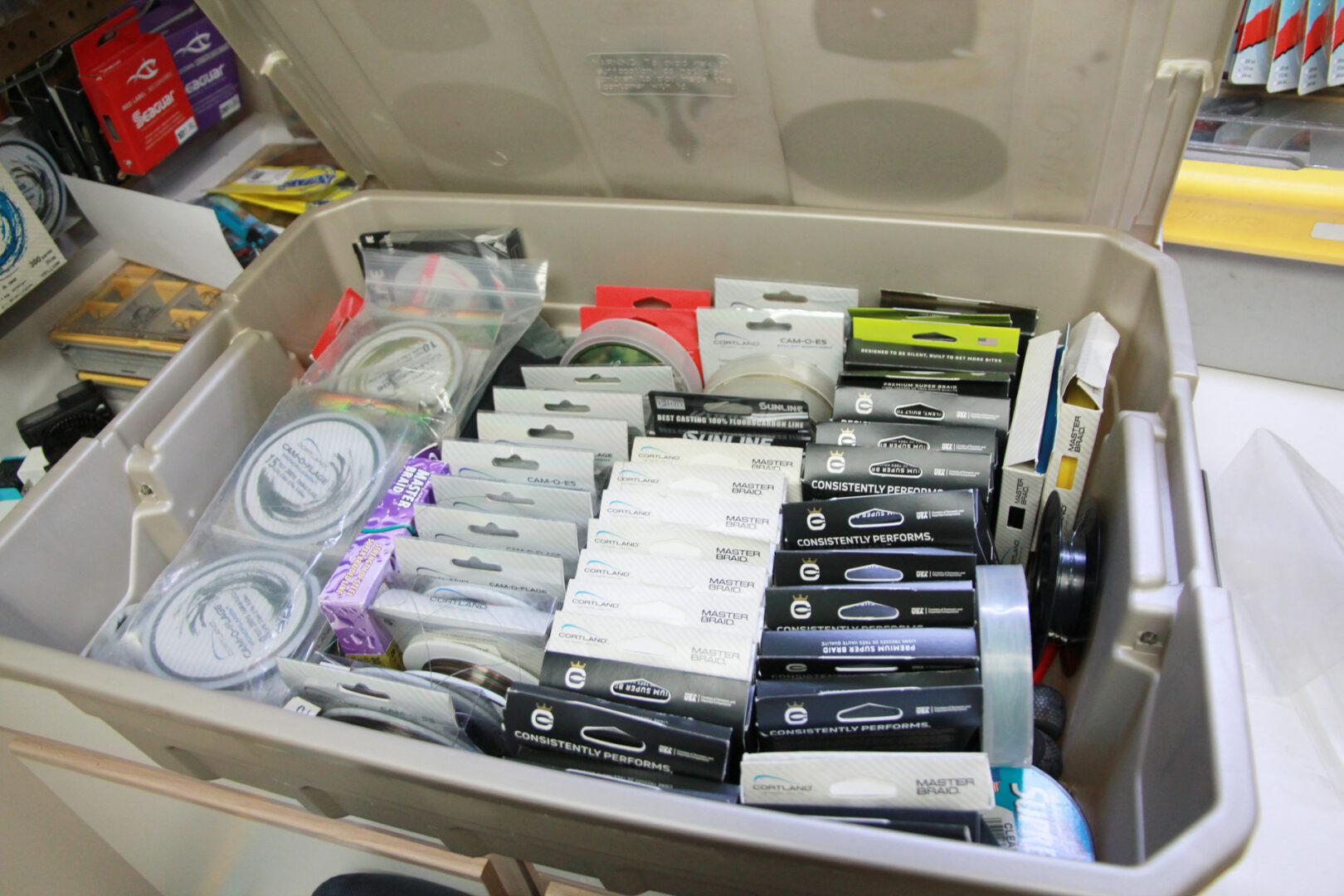
Due to the potential of line rot, I will only procure bulk spools if they are of braid, as the bulk spool option and longest shelf life is a guaranteed savings. For all monofilament and most fluorocarbon lines, you’ll be better off buying spools with only 200 or 300-yard capacities. Only if you go through several yards per season and don’t mind respooling annually to keep them fresh, you could then be better-off with bulk spools as a potential cost-saving measure.
Under these storage settings and requirements, I am able to store several unopened and used spools of lines that have hung on my peg boards for 5 to 10 years, and continue to withstand the test of time and these elements.
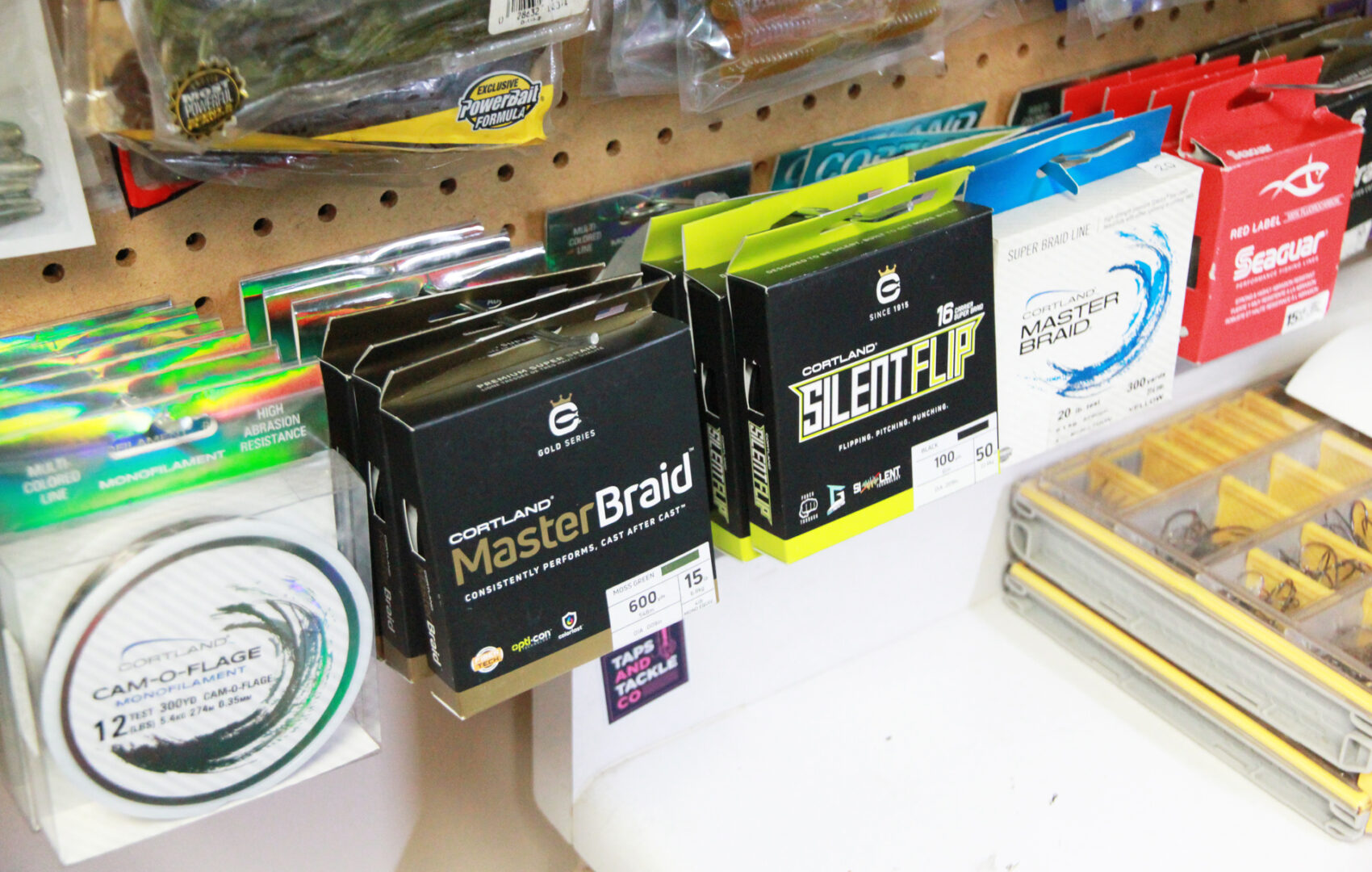
Line is your link to the fish. Any slight imperfections or neglect will be the difference between catching fish or failure.
Whether casting with braids, fluorocarbons, copolymers or monofilaments, each line type requires proper maintenance and upkeep in order to continue performing. These practices will also help prolong the shelf life of your favorite lines, and their continued performance. Follow-through with some of these methods and line insights, and you’ll be able to use a spool of line for a much longer time.
Andrew Ragas splits time between the Chicago area and Wisconsin’s Northwoods. Based in Minocqua, WI, he specializes in trophy bass fishing and offers guided trips from May thru October. While big bass is the passion, he dabbles in multi-species as well. He may be visited online at www.northwoodsbass.com


